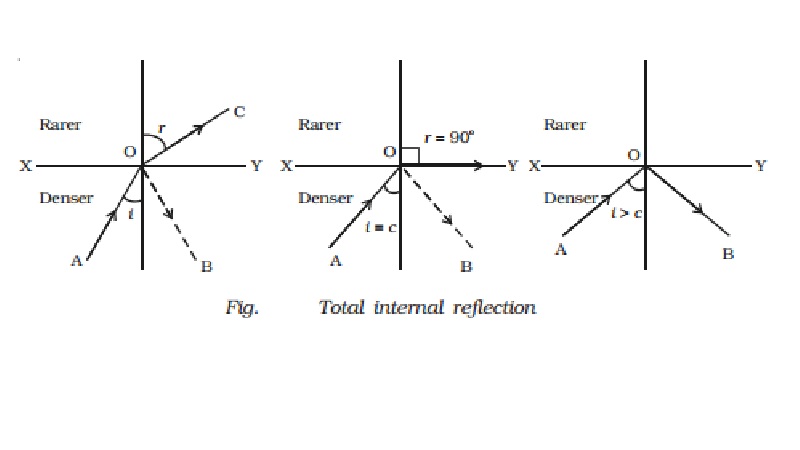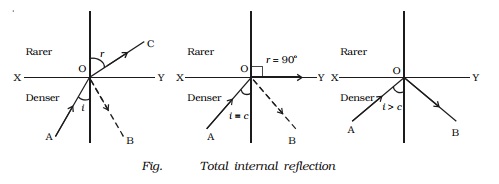Chapter: 11th 12th std standard Class Physics sciense Higher secondary school College Notes
Total internal reflection

Total internal
reflection
When
a ray of light AO passes from an
optically denser medium to a rarer medium, at the interface XY, it is partly reflected back into the
same medium along OB and partly
refracted into the rarer medium along OC
(Fig.).

If
the angle of incidence is gradually increased, the angle of refraction r will also gradually increase and at a
certain stage r becomes 90o.
Now the refracted ray OC is bent so
much away from the normal and it grazes the surface of separation of two media.
The angle of incidence in the denser medium at which the refracted ray just grazes
the surface of separation is called the critical angle c of the denser medium.
If i is increased further, refraction is
not possible and the incident ray is totally reflected into the same medium
itself. This is called total internal reflection.
If ?d is the refractive index of the denser medium then, from Snell?s
Law, the refractive index of air with respect to the denser medium is given by,
d?a = sin i
/ sin r
?a/ ?d
= sin i / sin r
1/ ?d = sin
i / sin r (since ?a = 1)
If r = 90o,
i = c
Sin c / sin 90o = 1/ ?d
Or
sin c = 1/ ?d
c = sin?1(1/
?d)
If the denser medium
is glass, c = sin -1(1/ ?g)
Hence for total
internal reflection to take place (i) light must travel from a denser medium to
a rarer medium and (ii) the angle of incidence inside the denser medium must be
greater than the critical angle i.e. i > c.
Critical angle for
some media
Medium : Refractive index , Critical angle
Water : 1.33 , 48.75 o
Crown glass : 1.52 ,
41.14 o
Dense flint glass
: 1.62
, 37.31o
Diamond : 2.42
, 24.41 o

Applications
(i) Diamond
Total
internal reflection is the main cause of the brilliance of diamonds. The
refractive index of diamond with respect to air is 2.42. Its critical angle is
24.41o. When light enters diamond from any face at an angle greater
than 24.41o it undergoes total internal reflection. By cutting the
diamond suitably, multiple internal reflections can be made to occur.

(ii) Optical fibres
The total internal
reflection is the basic principle of optical fibre. An optical fibre is a very
thin fibre made of
glass or quartz having radius of the order of micrometer (10?6m). A
bundle, of
such thin fibres forms
a ?light pipe? (Fig.a).
Fig. b shows the
principle of light transmission inside an optical fibre. The refractive index
of the material of the core is higher than that of the cladding. When the light
is incident at one end of the fibre at a small angle, the light passes inside,
undergoes repeated total internal reflections along the fibre and finally comes
out. The angle of incidence is always larger than the critical angle of the
core material with respect to its cladding. Even if the fibre is bent or
twisted, the light can easily travel through the fibre.
Light pipes are used
in medical and optical examination. They are also used to transmit
communication signals.
Related Topics